Truth be told we’re not huge fans of the Jaguar E-Type here at AUSmotive. We appreciate the landmark car that it is, but it’s just that, well, its design is terribly overrated, we think.
That said, this Lightweight E-Type project, which Jaguar has commissioned the newly formed Jaguar Heritage division of its Special Operations to create, is one of the most admirable moves any automotive manufacturer will make all year.
Back in 1963 Jaguar signed off a run of 18 Special GT E-Types to be built at the company’s Browns Lane factory in Coventry. The Special GT E-Type was designed to be a competition only model built with an all-aluminium body. For reasons not made clear only 12 of the 18 were made. Until now.
Using the remaining chassis numbers assigned 41 years ago Jaguar will now build the “missing six” as they are calling them. Production will take place at a refurbished Browns Lane facility allowing Jaguar’s craftsmen to pore over every detail as they hand build each car one by one.
The car you’re looking at here is known as “Car Zero” and is essentially the sales brochure for the final cars which will be built and sold to six lucky customers.
Further adding to this car’s cachet is the 3.8 litre straight six engine which lies beneath that evocative bonnet. With its roots dating back to the XK from 1948 the Lightweight E-Type engine is based on the D-Type motor which took Jaguar to victory at Le Mans in 1957. The customer can choose to have mechanical fuel injection as fitted to Car Zero or proper old skool carburettors, three Weber 45DCO3s to be precise. Power is nominated at 340hp complemented by 380Nm of torque.
Pricing hasn’t been mentioned in any official text from Jaguar and we suspect if sir or madam has to ask, then sir or madam can probably not afford it. If you can splash the cash to get yourself one of these truly collectable E-Types then clear your diary for a date with Jag’s design guru Ian Callum so you can sit down with him and personally discuss your preferences, paint colour and so on.
Really, this is just such an incredibly cool project and Jaguar cannot be applauded enough for making it happen.
Jaguar Land Rover Special Operations reveals ‘new’ Lightweight E-Type
IN BRIEF
- Jaguar Land Rover Special Operations has unveiled its ‘new’ Lightweight E-type – hand-built by highly skilled Jaguar craftsmen in a new facility at Browns Lane
- The new Lightweight E-type is the first recreation to come from Jaguar Heritage, which operates within the Jaguar Land Rover Special Operations division
- Just six customer Lightweight E-types will be built – each assigned one of the remaining chassis numbers originally allocated in 1963 to the intended 18-car ‘Special GT E-type’ project, of which just 12 were built
- The new Jaguar Heritage customer workshop facility at Browns Lane is now open to offer Jaguar warrantied servicing and restoration of classic Jaguar models
- In recreating the Lightweight, Jaguar Heritage has drawn on Jaguar’s unique engineering and design resources, including the company’s world-leading aluminium body technology
- The specification includes an aluminium bodyshell with doors, trunklid, hardtop and bonnet also in aluminium, and is assembled to exacting standards
- The six-cylinder XK engine mirrors the original power units, with an aluminium block, ‘wide angle’ aluminium cylinder head and dry sump lubrication
- The cars will be sold as period competition vehicles and all will be suitable for FIA homologation for historic motorsport purposes
- Only 12 of the original Lightweight E-types were built, all but one leaving Jaguar’s Browns Lane competitions department in 1963 (the last car was delivered in 1964)
- A prototype Lightweight – ‘Car Zero’ – has been completed and, on 14 August, will be revealed at the opening reception to the Pebble Beach Automotive weekend, the world’s most prestigious classic car event
“Special Operations’ remit is to indulge our most discerning and enthusiastic customers’ passion for our cars – including those from our past. This is why our Jaguar Heritage division exists, and why the new Lightweight E-type is such an incredibly exciting project.
“The E-type is an iconic car, and the Lightweight E-type the most desirable of all. To be able to complete the intended production run of 18, some 50 years after the last Lightweight was completed, was an opportunity we couldn’t miss.â€
– John Edwards, Managing Director, Jaguar Land Rover Special Operations
IN DETAIL
Jaguar has revealed the prototype of its ‘new’ Lightweight E-type – a further six of which will be built and sold.
Jaguar announced in May 2014 that it would recreate six new Lightweights, each built by Jaguar Heritage, part of Jaguar Land Rover’s new Special Operations division.
Each of the six cars will be built to a specification originated from the last Lightweight E-type produced in 1964 and will be hand-crafted at the original home of the E-type, Jaguar’s Browns Lane plant in Coventry, England. The cars will be sold as period competition vehicles and all will be suitable for FIA homologation for historic motorsport purposes.
The new cars are the ‘missing’ six vehicles from the ‘Special GT E-type’ project, which originally started in February 1963 with the objective of building 18 cars. Only 12 of the aluminium-bodied Lightweight E-types were eventually built and the remaining six designated chassis numbers having lain dormant, until now. The six new cars will carry those original, historic Lightweight E-type chassis numbers.
A race winner in the hands of a variety of famous drivers during its short competitive career, the car has achieved worldwide fame and original examples are now valued in the many millions. In recreating the Lightweight E-type, Jaguar Heritage has been able to call on the superlative skills and experience of many talented engineers and technicians already working in a variety of departments within Jaguar.
All, when offered the chance to assist with this unique project, leapt at the opportunity. Some even have an indirect link with the E-type when it was new: one master technician calculated that his family – including his grandparents, his father and his uncle – had a collective 170 years’ service at Jaguar stretching back to the early 1960s.
The expertise and attention brought to bear on this recreation project is staggering, with the full resources of Jaguar being applied to ensure that the six new Lightweights will not only be authentic, but will also be built to the highest quality standards.
So the six chosen customers will each receive the rarest of things – a brand new Lightweight E-type, hand-built at Browns Lane and just as desirable as one of the originals.
“Operating from a brand new workshop at Browns Lane – now open for the restoration and servicing of customer cars – the building of six new, meticulously crafted Lightweight E-type period competition cars by Jaguar Heritage is testament to the unique skills within the team. To know those same skills can also be utilised to the benefit of existing classic Jaguar owners means this is a very exciting time for Jaguar Heritage.â€
– Derek Weale, Director, Jaguar Heritage Business
Engineering
The bodyshell
The core component of the Lightweight E-type is its aluminium bodyshell. This material replaced the steel of the production E-type in the quest to shed weight – some 250lb (114kg) were saved compared with the standard car.
Despite the 50-year gap, the aluminium build of the six new Lightweights gives them an immediate affinity with the current Jaguar range, the F-TYPE and XJ models being built to exacting standards with aluminium bodies for exactly the same reason. In fact, Jaguar is now the world’s leading manufacturer of aluminium-bodied cars and the company has unrivalled experience in the relatively new field of applying aluminium technology to volume production cars.
So when tasked with the job of recreating the Lightweight E-type’s aluminium body, today’s Jaguar engineers could relate at once to what their predecessors had achieved 50 years before. However, despite the enormous advances in technology since the early 1960s, the decision was taken not to incorporate modern materials or fixing methods. While high-strength aluminium alloys and bonded structures would have been invisible, they would not have been true to the original design – and nor would they have conformed to the FIA’s homologation requirements for historic racing.
Instead, today’s advanced technology was deployed to ensure the highest quality and most faithful rendition of the Lightweight E-type’s open two-seater body components. Using state-of-the-art scanning technology, the inner and outer surfaces of a Lightweight bodyshell were digitally mapped.
The resulting massively detailed scan, which recorded dimensions and shape down to a fraction of a millimetre, was then assessed by Jaguar’s technicians to validate how the body was assembled back in the 1960s, how consistent the structure was side-to-side, and how it could be engineered today to produce the highest quality result for the Lightweight E-type project.
As this digital capturing process gave Jaguar’s engineers complete control over the Lightweight E-type body’s 230 individual components, their shapes could then be optimised before the data was sent to the tool room at Jaguar’s Whitley engineering centre. Even panels which are unseen within the structure have been faithfully reproduced. To ensure absolute symmetry, one side of the scanned body was used as the datum, this being ‘flipped’ to produce an identical condition on the opposite side.
Additionally, before being signed-off, the outer ‘A-surface’ CAD scan was transferred to Jaguar’s design department where the surface geometry was finalised. All this work ensured that the tooling from which the majority of the new body parts are produced is as accurate as possible.
Approximately 75 per cent of the panels are made in-house at Whitley, just a few very large pressings being supplied by external specialists using Jaguar-designed tooling. The grades of aluminium used for both the under-structure and surface panels are almost identical in mechanical properties to those used for the original 1963 Lightweight E-types. The body is completed to original Lightweight E-type Chassis no. 12 condition, by which time Jaguar had added some additional strengthening in key areas of the shell. The aluminium body is then completed by the addition of an aluminium bonnet, doors and trunk lid. As with the original cars, an aluminium hard top is standard.
The development of the body-in-white tooling was undertaken by the same department that builds all Jaguar Land Rover prototype vehicles, so the expertise applied to the project was world-class. The build process and assembly procedures were initially proved out on Car Zero; this is effectively an engineering prototype and will not carry one of the six Lightweight chassis numbers.
For the Lightweight E-type project, Jaguar’s engineers created a ‘grey book’ of the type used during the development of new production Jaguars. This internal document sets out the required quality standards in terms of bodyshell fit-and-finish and ensures a consistency of build quality for all six new Lightweight E-types.
A roll-over cage is fitted as standard, and the body includes mounting points for a detachable front extension which is available as an extra. The cars are built in a form suitable for FIA homologation for historic motorsport purposes (see full specification).
The engine and drivetrain
The Lightweight E-type was powered by a highly developed version of Jaguar’s straight-six XK engine which, with its chain-driven twin overhead camshafts and aluminium head with hemispherical combustion chambers, remained highly advanced in 1963 even though it had first been seen in the XK 120 as far back as 1948.
It was this engine that had powered the C- and D-types to five Le Mans victories in the 1950s, and the unit developed for the Lightweight E-type is based on the 3,868cc (236 cu in) engine which, in the D-type, had won Le Mans in 1957. A similar big valve ‘wide angle’ cylinder head is used, but in place of the D-type’s cast iron block, Jaguar introduced an aluminium block for the Lightweight E-type which substantially reduced the amount of weight over the front wheels. This also features in the present-day car, with pressed-in steel liners.
Another major feature transferred from the D-type is the dry sump lubrication system. This uses a scavenge pump to collect oil from the sump and return it to a separate oil tank in the underbonnet area. This eliminates oil surge during fast cornering and consequent risk of damage to the engine’s bearings, and also allows a greater quantity of oil to be carried.
The compression ratio is 10:1 and today’s car is supplied with three 45DCO3 Weber carburettors. These were homologated by Jaguar for the Lightweight E-type in addition to a Lucas mechanical fuel injection system – which is being offered to customers as a cost-option (and which is fitted to Car Zero). The exhaust manifold is a steel fabrication and leads the exhaust gasses into twin pipes which take them through a centre silencer box to the rear of the car, where the exhaust system ends in twin polished tail pipes.
Whether carburettors or fuel injection is specified, brake horsepower is well over 300, and with torque in the region of 280lb ft at 4500 rpm, the car is endowed with rapid acceleration from comparatively low engine revs – a traditional feature of Jaguar racing engines.
A 12 volt negative earth electrical system is used, and the engine benefits from a modern inertia-type starter motor. The water and oil radiators are in aluminium alloy, there is an aluminium expansion tank for the coolant, and the fuel tank is mesh-filled for safety.
The power is transferred to the road via a lightweight, low inertia flywheel, a single-plate clutch and a Jaguar close-ratio, manual four-speed all-synchromesh gearbox as used by the Lightweight E-type in period. A variety of final drive ratios are available, all with the Powr-Lok limited-slip differential, but a 3.31:1 ratio is supplied as standard.
Suspension, steering and brakes
The twin wishbone front suspension and independent wide-based wishbone rear suspension (where the drive-shaft serves as the upper link) are set-up according to period racing practice, with uprated shock absorbers controlling the torsion bar springs (front) and the four coil springs (rear).
The steering is the excellent standard E-type rack-and-pinion, with a traditional wood-rim wheel for the driver. Larger (12.25in) brake discs are fitted at the front, with the rear brakes being standard E-type. No servo is fitted.
The 15in diameter wheels are period type in the correct ‘perforated’ style, and like the originals are cast in magnesium alloy. Rim width is 7in front, 8in rear. Dunlop racing tyres are fitted, 6.00 section front, 6.50 section rear, both in CR65 compound.
Final assembly
The monocoque bodyshell is built at Whitley where it is mated to its tubular engine sub-frame – which is stiffened with gussets as for the original Lightweight – and then shipped to Jaguar’s Gaydon facility for painting. From there it is then taken to Jaguar Heritage at Browns Lane where the car is built up with powertrain, suspension, brakes, steering, electrical items, instrument panel and soft trim.
This process takes place in a dedicated area close to where the original Lightweight E-types were assembled in 1963/64, and the work is undertaken by highly skilled technicians used to assembling extremely complex JLR prototypes.
It is at this stage that personal consultation with the customer dictates the final specification for each individual car – no two of which are expected to be identical.
Car Zero underwent a 15-day shake-down period at Jaguar Land Rover’s test facility at Gaydon to prove out the car’s dynamics and establish optimum suspension settings. This involved Mike Cross, Jaguar’s Chief Engineer, Vehicle Integrity. Jaguar’s engineers even established a ‘design verification plan’ for the car, just as they would do for an entirely new model. Each of the six new Lightweights will go through shake-down tests to ensure that they meet the required standards in terms of braking, handling and steering.
“In our contemporary Jaguar sports cars our aim is always to achieve an immediacy of response to all driver inputs – and the goal with Lightweight E-type was the same. For me, its response to steering, brake and throttle inputs – along with the terrific noise it creates – is what makes it such an engaging machine from the driver’s seat.â€
– Mike Cross, Chief Engineer, Vehicle Integrity, Jaguar
Design
Jaguar’s Advanced Design Studio has been involved in the project from an early stage, charged with arriving at the appropriate level of trim for the new car, together with selecting the materials used and the nature and colour of finishes.
“With the Lightweight E-type, our focus as a design team has been to ensure justice was done to the original work of Sir William Lyons and Malcolm Sayer. Meticulous attention to detail has been everything to us in re-creating this car, just as it is in our contemporary Jaguars. I believe the result is a new Lightweight E-type that is as stunning now as the originals would have been when they were new.â€
– Ian Callum, Director of Design, Jaguar
Connolly leather is used, supplied by Jonathan Connolly with hides produced to the same specification as those used by Jaguar in the 1960s. This leather is used to trim the competition-type aluminium bucket seat base. The centre console covering is also leather, and there is a choice of seven trim colours.
As befits a thoroughbred GT car where weight saving in all areas is demanded, interior trim is minimal. However, the customer can opt for a more fully-trimmed car and the Jaguar team can devise bespoke trim packages. This may include door cards, headliner for the hardtop, removable custom saddle-leather floor mats, and a cover for the transmission tunnel.
Much of Car Zero’s interior – floorpan, sills, rear areas – have intentionally been left unpainted, to emphasise the car’s aluminium bodywork.
The studio has also selected a palette of six ‘heritage’ paint colours recommended for the exterior: Carmine red, opalescent grey metallic, silver metallic, opalescent blue metallic, British racing green, Old English white. However, various colour and trim alternatives are available, as each car is built to the personal specification of each individual customer, who can discuss options with Jaguar’s Director of Design, Ian Callum, in person.
LIGHTWEIGHT E-TYPE SPECIFICATION*
Engine System
- Engine: Aluminium six-cylinder block, wide-angle cylinder head, dry sumplubrication, lightweight low-inertia flywheel
- Displacement: 236.0 cu in (3,868cc)
- Bore/Stroke: 3.46in/4.17in (88.0mm/106.0mm)
- Valvetrain: 2 valves per cylinder, DOHC
- Compression ratio: 10:1
- Carburettors: Triple 45DCO3 Weber
- Injection (optional): Lucas mechanical, 6.25in (158.7mm) butterfly trumpets
- Crankshaft: Steel with steel H-section con rods
- Power: 340hp/253.5kW @ 6500rpm
- Torque: 280lbs ft/380Nm @ 4500rpm
- Fuel tank: Mesh-filled 14-gallon (64-litre) capacity
- Fuel pump: Standard E-type
- Transmission and Driveline
- Transmission: Jaguar 4-speed all-synchro close-ratio gearbox
- Final drive casing: Cast iron, Powr-Lok limited slip differential, axle ratio 3.31:1
- Gearbox oil: Castrol
- Clutch: Single dry plate
- Suspension and Steering
- Front: Double wishbone, LWE torsion bars, uprated anti-roll bar
- Rear: Jaguar independent rear suspension lower wishbones/driveshaft links, radius arms, anti-roll bar (C/O Standard E-type rear springs with uprated damper assemblies)
- Steering: Standard E-type rack-and-pinion, adjustable steering column
Brakes
- Brake discs (front): 12in Dia (305mm)
- Brake discs (rear): 11.25in Dia (286mm)
- Handbrake: Production E-type
Wheels and Tyres
- Magnesium disc wheels: Front: 15in x 7.0J, Rear 15in x 8.0J
- Tyres: Dunlop (Front – 6.00L15 CR65, Rear – 6.50L15 CR65)
Electrical
- Battery: 12v – 62 amp / hour
- System: 12v negative-earth
- Lighting: Tungsten headlamps and standard rear tail-lamps
- Ignition: Electronic
- Instruments: Smiths Industries
- Generator: Production E-type
- Starter: Production E-type
- Control Box: Production E-type
- Wiper motor and blades: Production E-type
Exhaust and Cooling
- Exhaust: Fabricated steel manifold, steel exhaust system with centre silencer box and twin polished tail pipes
- Cooling: Aluminium E-type radiator, aluminium expansion header tank, engine oil cooler, oil sump tank
Overview
- Length: 175.3in (4,453mm)
- Width: 66.9in (1,700mm)
- Height: 46.5in (1,181mm)
- Weight: 2204.6lbs (1,000kg)
- Wheelbase: 96.1in (2,440mm)
- Front Track: 50.0in (1,270mm)
- Rear Track: 55.0in (1,397mm)
BODY TRIM & HARDWARE
Body in white & closures
- Aluminium monocoque with stiffened front sub-frame for race engines above 300bhp
- Riveted and welded aluminium construction
- Aluminium body closures (bonnet/doors/trunk-lid)
- Aluminium detachable hard top roof
- 21 louvre bonnet air intakes
- Black powder-coated roll cage
- Front brake cooling ducts integrated with bonnet structure
Exterior trim
- Side bonnet-release handles
- ‘Long range’ aluminium quick release fuel cap
- Body colour cabin ventilation air intakes
- Protective car cover (non-waterproof)
- Centre bonnet catch
- Oval door mirror upgrade
Interior Trim
- Aluminium bucket seats with increased backrest angle and padded cushions
- Rear-view mirror
- Leather selection from Connolly palette
- Wood-rimmed steering wheel
- Aluminium gear knob and standard hand brake
- Machined metal toggle and push button starter
- Five-point seat belt
- Black instrument panel with glove box
- Bonnet and boot stands
Glass house
- Clear laminated front screen
- Perspex side windows and rear screen
- Manual slide side windows
*Figures are manufacturer’s estimates, subject to change according to customer specification
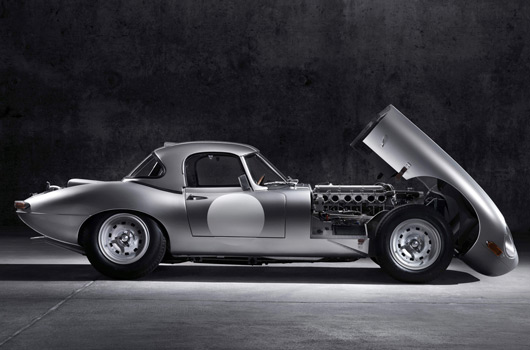
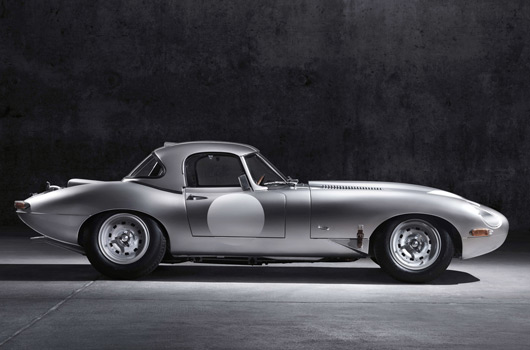
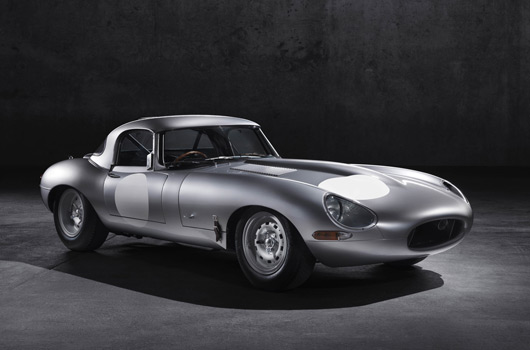
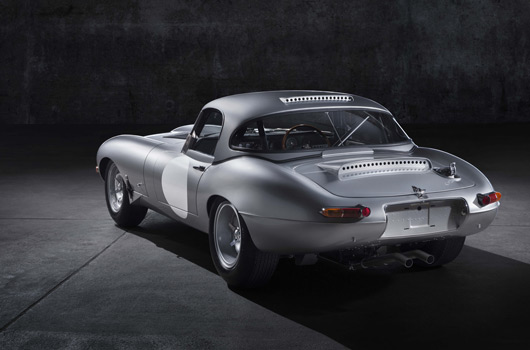
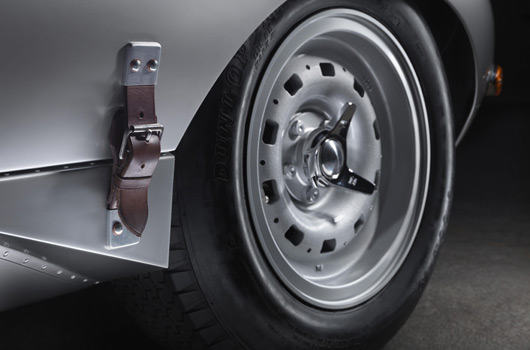
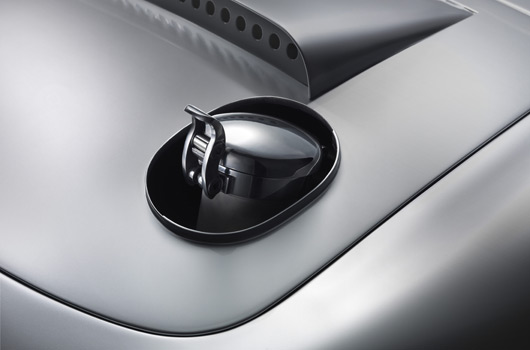
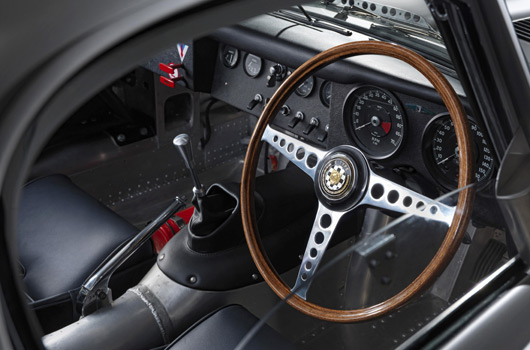
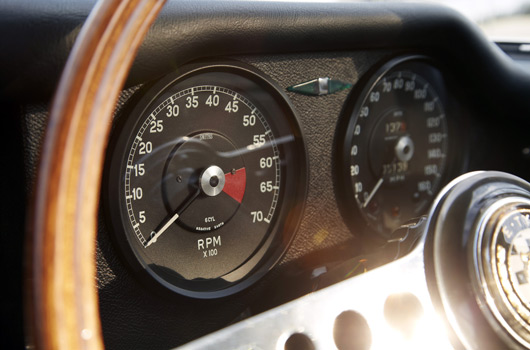
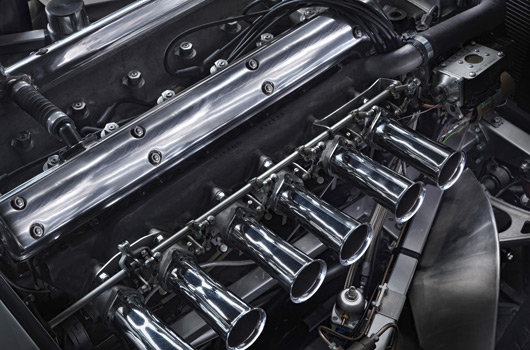
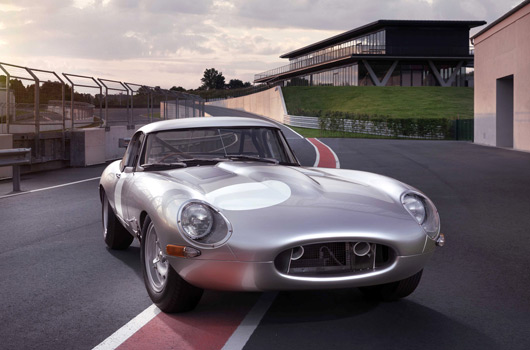
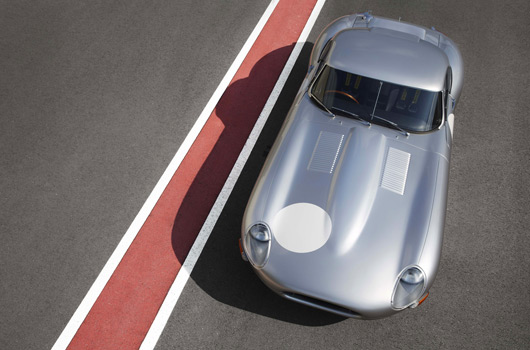
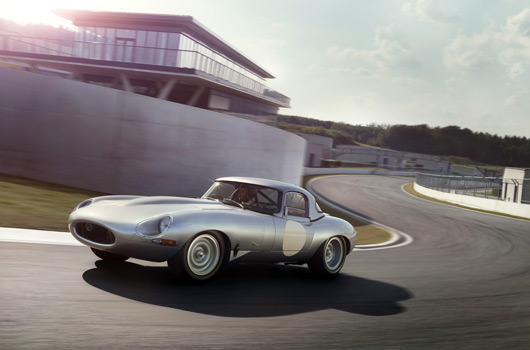
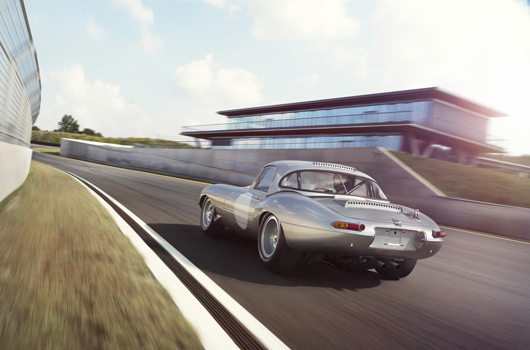
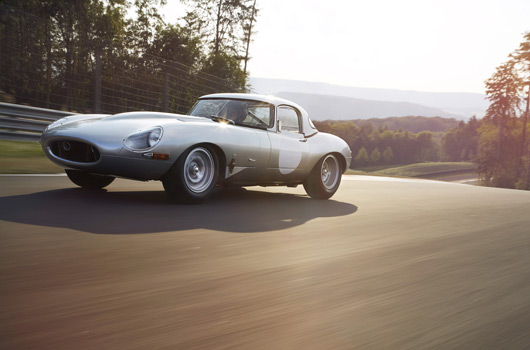
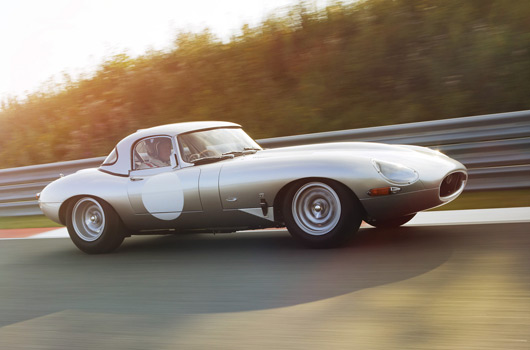
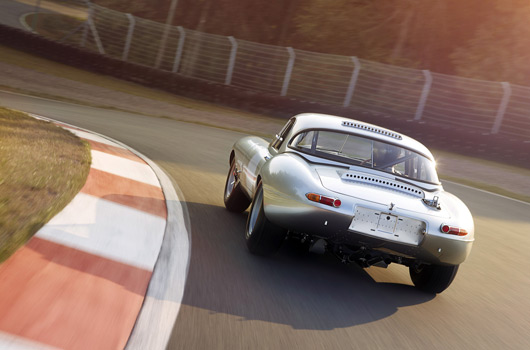
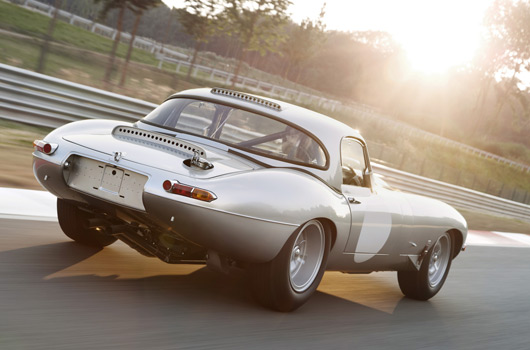
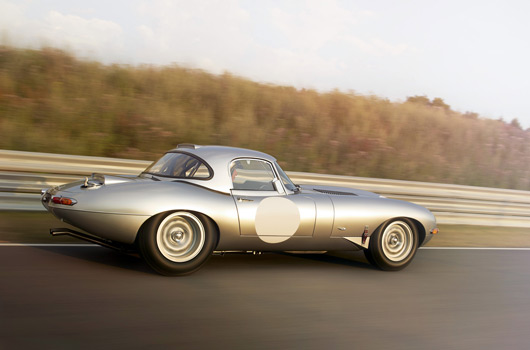
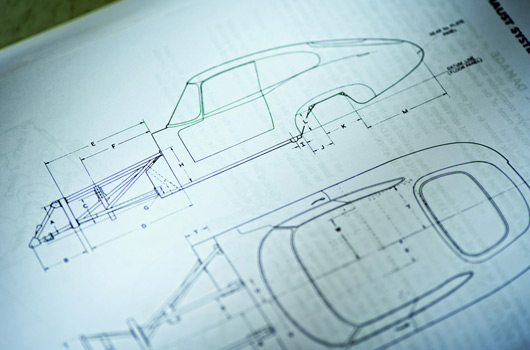
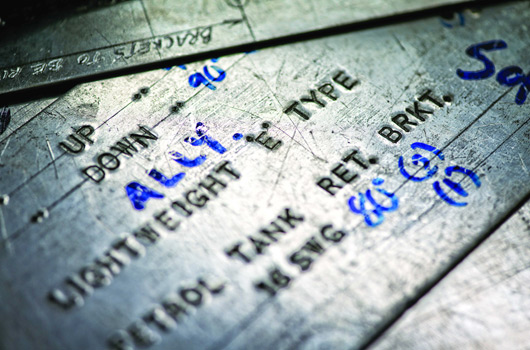
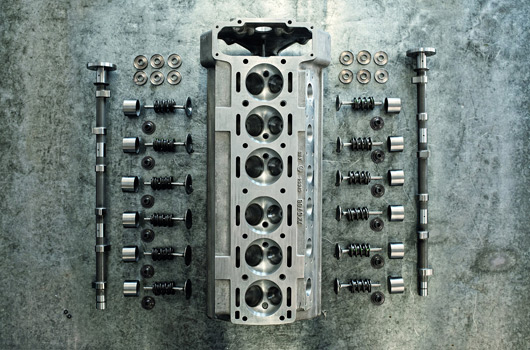
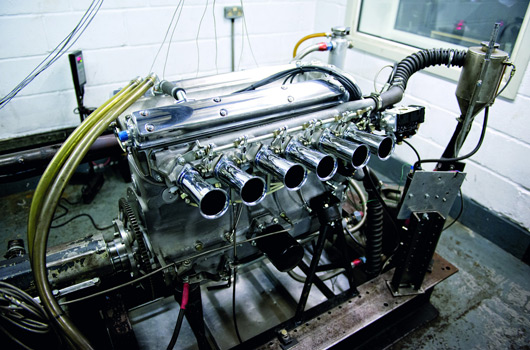
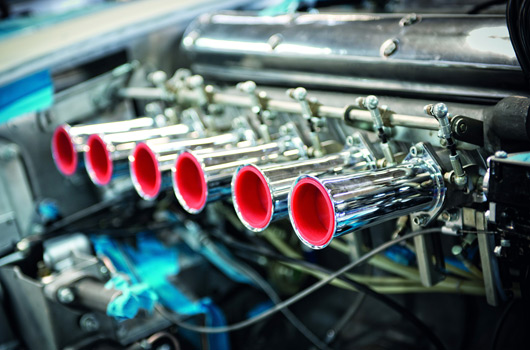
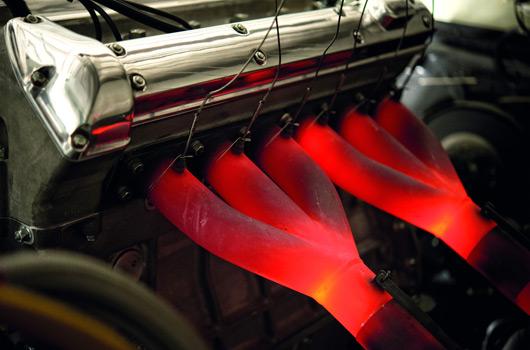
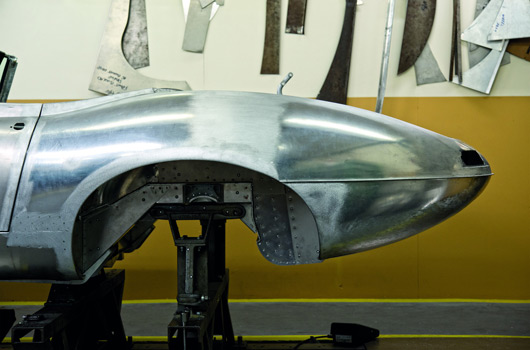
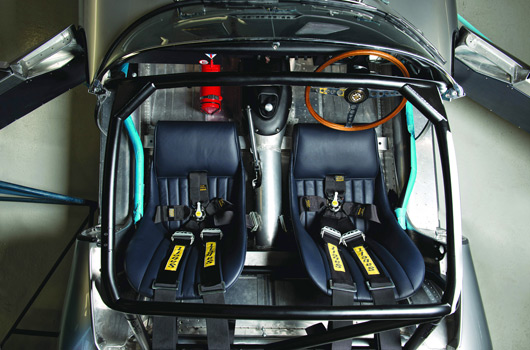
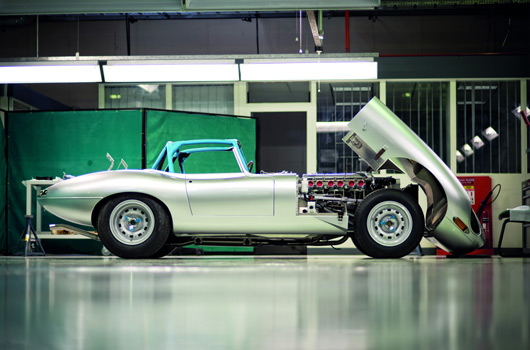
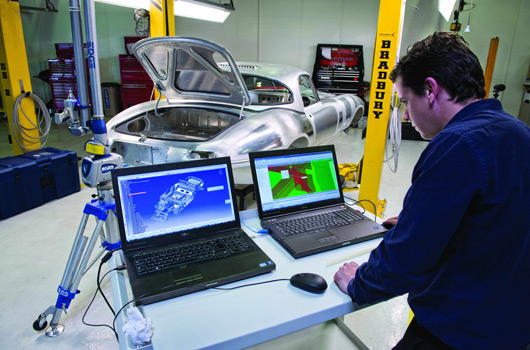
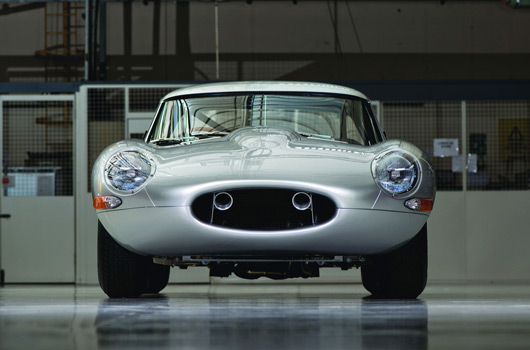
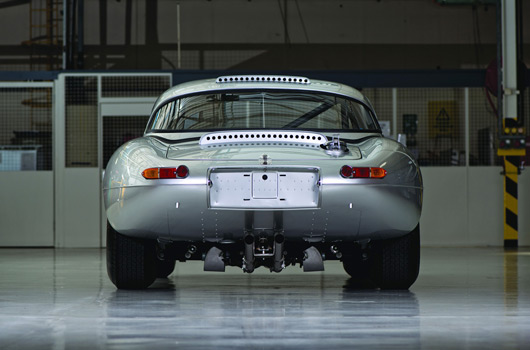
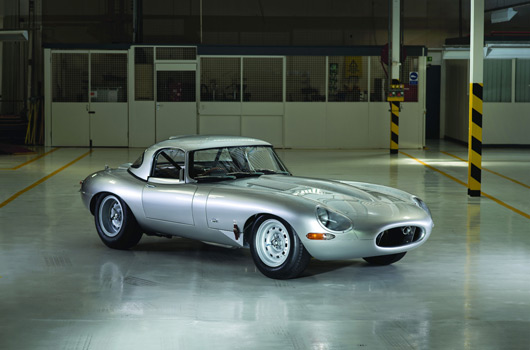
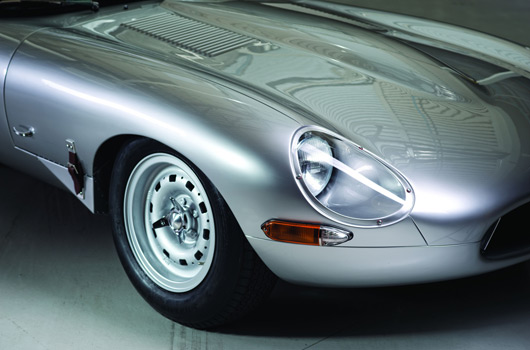
7 replies on “Jaguar Lightweight E-Type revealed”
E type design overrated? Are you serious??? It’s to me one of the most beautiful automotive design ever! And I’m not huge on retro cars. Anyway, this is apparently going to cost a cool million pounds each, but I’m sure they will be snapped up and probably already have by the time you published this. Well done Jaguar. Now can Mercedes build the 190SL so I can buy one.
I’ll be surprised if Ratan Tata himself doesn’t snap one up! Btw, when Tata bought Jaguar and Land Rover, he pledged to revive the brands and bring them back to their iconic status. 6 years on, the report card looks very very good for both brands!!! So don’t fear the next time and Indian or Chinese company put their hand up to purchase an iconic automotive brand. Can’t be long before Lotus is up for sale.
“E type design overrated?”
Yep, have never seen the appeal. I respect what the E-Type did for the price and what it could do on the road but the way people gush over its design is not something I can relate to.
On the standard car the wheels are tucked in way too far, the bonnet is stupidly long and it’s just not as visually appealing as say a Ferrari 250 GTO or a Mercedes 300SL.
I’d put even the AC Cobra ahead of an E-Type insofar as pure design is concerned.
…..but Enzo Ferrari called it the most beautiful car in the world!!
For what it’s worth, I think the wheels on this version make it look much nicer. I not big on British sports cars, they rust wothout any grace.
I love your against the grain opinion re this car Liam. I’m not as down on it but agree that it is a little gushed over.
Not too keen on car companies building their own replicas, there should always be a large separation between the two in my opinion. I sincerely hope that the FIA does not give in and homologate it for historic competition.
I agree with Liam. The awkward looks of the E-Type could be worth coping with if it was a brilliant car underneath the skin, but it’s a shit car that was further compromised by terrible build quality at the hands of slovenly Midlanders who tended to spend more time picketing the factory than working in it.
If you want a 60’s/70’s car with awkward (but slightly cool) looks that would be a nightmare to drive, you’d go for a Porsche 911.
The tastelessness of those of you commenting here is second only to tattooed women and men who insist on wearing their baseball hat, complete with sunglasses on top, at the dinner table. Yes, the E-Type is gorgeous, and yes, “gorgeous” is a relative term. …and saying that the Ferrari 250 GTO is “more beautiful” than this or that is a meaningless comparison, more especially considering that the E-Type spanked the 250 GTO at Le Mans. So… “I think I’ll compose an article slamming the quality, looks and performance of the Jaguar XKE, and then tell everyone how cool it is that 6 more are being built.” If there’s something in particular you don’t care for, why pen a composition praising an effort to revive it? Drivel. If you all go quickly enough, perhaps you and your tattooed lady will catch the end of a NASCAR race on the telly. Don’t forget your baseball hats.